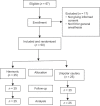A Comparative Study of the Use of Harmonic Scalpel versus Unipolar Cautery in Modified Radical Mastectomy
- PMID: 28584507
- PMCID: PMC5441211
- DOI: 10.4103/1117-6806.199962
A Comparative Study of the Use of Harmonic Scalpel versus Unipolar Cautery in Modified Radical Mastectomy
Abstract
Context: Oncosurgery is an emerging branch with the set goals of prolonging the life and ensuring the best possible quality of life to the surviving patient. The use of harmonic scalpel has proved to be beneficial in a variety of surgeries but its role in breast surgery is still controversial.
Aims: We conducted this study to compare the intraoperative and postoperative outcomes in modified radical mastectomy using harmonic scalpel versus electrocautery.
Subjects and methods: Fifty female patients with confirmed diagnosis of breast carcinoma and planned for modified radical mastectomy were taken up for surgery. Twenty-five patients were operated using harmonic scalpel (Group A) and another 25 were operated using unipolar cautery (Group B).
Results: The mean operative time was significantly longer with harmonic scalpel when compared to that with electrocautery (140.40 ± 29.96 vs. 99.80 ± 24.00 min, P < 0.001). The smaller amount of drainage content (431.60 ± 145.94 vs. 594.20 ± 278.63, P = 0.013) and intraoperative blood loss (426.00 ± 76.54 vs. 502.00 ± 104.56, P = 0.005) in the group operated with the ultrasound harmonic scalpel was statistically significant. There was no significant difference between the groups with regard to drain duration (5.24 ± 0.97, P = 0.127), seroma (12% vs. 16%, P = 0.684), hematoma (4% vs. 4%, P = 1.000), wound infection (24% vs. 32%, P = 0.529), flap necrosis (8% vs. 28%, P = 0.066), pain intensity (measured on visual analog scale) (5.08 ± 1.29 vs. 5.20 ± 1.68, P = 0.778), and lymphedema (4% vs. 8%, P = 0.552). The length of hospital stay could not be compared effectively because all the patients were discharged on the 10th or 11th postoperative day. The cost of the equipment used in the electrocautery group was almost negligible as compared to the harmonic group.
Conclusions: The use of harmonic scalpel versus electrocautery is somewhat advantageous but not cost-effective.
Keywords: Harmonic scalpel; modified radical mastectomy; unipolar cautery.
Conflict of interest statement
There are no conflicts of interest.
Figures
Similar articles
-
Comparison of Intraoperative and Postoperative Outcomes With Skin Flaps Raised Using Either Harmonic Scalpels or Electrocautery During Modified Radical Mastectomy.Cureus. 2024 Jun 13;16(6):e62320. doi: 10.7759/cureus.62320. eCollection 2024 Jun. Cureus. 2024. PMID: 39006650 Free PMC article.
-
Comparing the Harmonic Scalpel with Electrocautery in Reducing Postoperative Flap Necrosis and Seroma Formation after Modified Radical Mastectomy in Carcinoma Breast Patients: A Double-Blind Prospective Randomized Control Trail.Cureus. 2018 Apr 13;10(4):e2476. doi: 10.7759/cureus.2476. Cureus. 2018. PMID: 29904617 Free PMC article.
-
Harmonic Scalpel versus Electrocautery Dissection in Modified Radical Mastectomy for Breast Cancer: A Meta-Analysis.PLoS One. 2015 Nov 6;10(11):e0142271. doi: 10.1371/journal.pone.0142271. eCollection 2015. PLoS One. 2015. PMID: 26544716 Free PMC article.
-
Comparison of harmonic scalpel and conventional technique in the surgery for breast cancer: A systematic review and meta-analysis.Indian J Cancer. 2018 Oct-Dec;55(4):348-358. doi: 10.4103/ijc.IJC_306_18. Indian J Cancer. 2018. PMID: 30829269
-
The harmonic scalpel versus electrocautery for parotidectomy: A meta - analysis.J Craniomaxillofac Surg. 2019 Jun;47(6):915-921. doi: 10.1016/j.jcms.2019.01.008. Epub 2019 Jan 10. J Craniomaxillofac Surg. 2019. PMID: 30954384
Cited by
-
A Comparative Study of Harmonic Scalpel Versus Electrocautery Dissection in Modified Radical Mastectomy in Breast Carcinoma Cases.Cureus. 2024 Aug 5;16(8):e66187. doi: 10.7759/cureus.66187. eCollection 2024 Aug. Cureus. 2024. PMID: 39105200 Free PMC article.
-
Comparison of Intraoperative and Postoperative Outcomes With Skin Flaps Raised Using Either Harmonic Scalpels or Electrocautery During Modified Radical Mastectomy.Cureus. 2024 Jun 13;16(6):e62320. doi: 10.7759/cureus.62320. eCollection 2024 Jun. Cureus. 2024. PMID: 39006650 Free PMC article.
-
Efficacy and safety of surgical energy devices for axillary node dissection: a systematic review and network meta-analysis.Breast Cancer. 2023 Jul;30(4):531-540. doi: 10.1007/s12282-023-01460-7. Epub 2023 Apr 14. Breast Cancer. 2023. PMID: 37058224
-
High-energy devices in different surgical settings: lessons learnt from a full health technology assessment report developed by SICE (Società Italiana di Chirurgia Endoscopica).Surg Endosc. 2023 Apr;37(4):2548-2565. doi: 10.1007/s00464-022-09734-5. Epub 2022 Nov 4. Surg Endosc. 2023. PMID: 36333498 Free PMC article.
-
Comparison of Harmonic scalpel and monopolar cautery for capsulectomy at the second stage of expander/implant breast reconstruction.Arch Plast Surg. 2020 Mar;47(2):140-145. doi: 10.5999/aps.2019.01130. Epub 2020 Feb 27. Arch Plast Surg. 2020. PMID: 32098006 Free PMC article.
References
-
- Brunicardi F, Andersen D, Billiar T, Dunn D, Hunter J, Matthews J, et al. Schwartz's Principles of Surgery. 9th ed. New York: McGraw-Hill; 2009. The breast; pp. 440–1.
-
- Odel RC. Laparoscopic electrosurgery. In: Hunter JG, Sackier JM, editors. Minimally Invasive Surgery. New York: McGraw-Hill; 1993. pp. 33–41.
-
- Voyles CR, Tucker RD. Education and engineering solutions for potential problems with laparoscopic monopolar electrosurgery. Am J Surg. 1992;164:57–62. - PubMed
-
- Matthews B, Nalysnyk L, Estok R, Fahrbach K, Banel D, Linz H, et al. Ultrasonic and nonultrasonic instrumentation: A systematic review and meta-analysis. Arch Surg. 2008;143:592–600. - PubMed
LinkOut - more resources
Full Text Sources
Other Literature Sources


